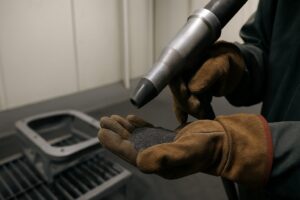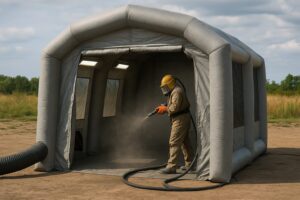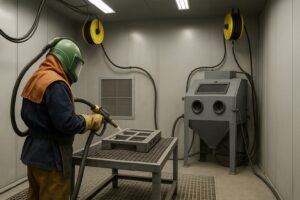For professionals who rely on blast media to prepare surfaces for painting, maintaining the quality of your abrasive material is crucial. Over time, blast media degrades, becomes clogged with debris, or loses its abrasiveness, leading to longer job times, uneven finishes, and potential damage to parts. Recognizing when your blast media needs replacement not only saves time and money but also helps you deliver consistent, high-quality results. In this blog, we’ll explore the key signs that indicate it’s time for fresh media, explain why addressing these issues promptly is important, and offer practical tips for maintaining an efficient blasting operation.
1. Visible Wear and Breakdown
One of the most straightforward indicators that your blast media is past its prime is visual inspection. High-quality media starts as uniform granules, but after repeated use, you may notice:
Rounded or Misshapen Granules
Fresh blast media typically features sharp edges and a consistent shape to maximize abrasive action. When granules become rounded or irregular, their ability to cut into surfaces diminishes, resulting in less aggressive cleaning.
Excessive Dust and Fine Particles
As media breaks down, it creates dust and fines that not only reduce cleaning efficiency but also create respiratory hazards and extra cleanup work in your booth. A fine, powdery residue in the collection hopper or on surrounding equipment is a red flag.
Color Changes or Contamination
Media often takes on the color or residue of the materials it removes—rust, paint, or coatings. While some color transfer is expected, heavy staining or a greasy film indicates that the media is saturated with contaminants and will no longer perform effectively.
Regularly scooping a small sample from your blast pot and inspecting it under good lighting can reveal these wear patterns. If over 20–25 percent of your media is dust or broken particles, it’s time for a full change.
2. Declining Cleaning Performance
Even if your media looks serviceable, you may notice it isn’t working as well as before. Performance issues can slip by unnoticed until they cost you time and effort later. Watch for:
Longer Cycle Times
When fresh media easily strips old coatings or rust in a single pass, but aged media requires multiple passes, you’re losing productivity. A sudden uptick in cycle time—say, an extra 30 percent more blasting per part—suggests your media’s cutting power has faded.
Uneven Surface Preparation
Consistency matters. If some areas come away clean while others still harbor stubborn spots, degraded media may be providing uneven impact energy. You could end up reworking parts or applying coatings over imperfect surfaces.
Increased Nozzle Wear
Ironically, as media breaks down into finer particles, it can accelerate nozzle erosion. Fines move faster through the nozzle and can form a grinding slurry, wearing out the inside of the nozzle more quickly than well-shaped granules. Frequent nozzle replacements hint at problematic media degradation.
Keep a log of cycle times and maintenance costs—when you see a trend of declining efficiency or rising expenses, factor in media replacement as part of the solution.
3. Safety and Quality Concerns
Blast media that no longer meets performance standards can introduce safety risks and compromise the final quality of your work:
Dust-Related Hazards
As media breaks into finer particles, it generates more airborne dust. Without proper dust collection, this can pose inhalation risks and reduce visibility inside the booth. Fine dust may also penetrate filters more easily, making respiratory protection less effective.
Contaminated Finishes
Media loaded with old paint, rust, or grease can re-deposit contaminants onto the workpiece. This not only affects coating adhesion but may also lead to corrosion under the new finish, resulting in costly rework or warranty claims.
Overpressure or Plugging
Clogged or fouled media can form bridges in the blast pot, causing sudden surges or blockages. These events can create overpressure that stresses hoses and fittings, increasing the risk of leaks or accidental exposure to high-pressure abrasive.
Maintaining media quality is part of an overall safety and quality assurance program. Substandard media undermine both.
4. Cost-Benefit of Replacement vs. Recycling
Many facilities recycle blast media to reduce material costs and environmental impact. While recycling can be effective, over-recycling leads to the very issues we’ve discussed. Consider these factors:
Recycling Capacity
Cyclone separators and vibratory screens can remove fines down to a certain size. If your recycling system is rated to handle 100 mesh and you consistently see media finer than that, it’s time to bleed off a portion of the media and add fresh material.
Blend Ratios
A good rule of thumb is to replace 10–20 percent of your media inventory each week, depending on usage intensity. For heavy production shops, replacing 20 percent every few days may be more appropriate.
Media Type Cost
Premium media (e.g., garnet or aluminum oxide) can be more economical to recycle, since residual value per pound is higher. Cheaper media (e.g., coal slag) may not justify extensive recycling efforts once it degrades, making full replacement more cost-effective.
By tracking media consumption rates, recycling efficiency, and the cost per pound, you can establish a data-driven schedule for media top-offs or full replacement.
5. Best Practices for Smooth Replacement
When the time comes to swap out old media for fresh abrasive, following best practices minimizes downtime and maintains booth performance:
Plan Ahead
Schedule media replacement during planned downtime or off-hours. That way, you avoid halting critical production unexpectedly.
Clean the Blast Pot
Before adding new media, empty and clean the pot, piping, and nozzles. Remove residual fines and contaminants to prevent mixing fresh media with old debris.
Inspect and Service Components
Take advantage of the empty system to check hoses, valves, nozzles, and the pot’s internal lining. Replace worn parts to ensure optimal performance with the new media.
Calibrate Pressure Settings
Different media grades and sizes require specific pressure settings. Consult manufacturer recommendations to adjust your system for the new abrasive, ensuring you don’t under- or over-blast.
Record the Change
Note the date, media type, mesh size, and quantity of fresh media added. Keeping accurate records helps you track media lifespan and refine replacement intervals over time.
Conclusion
Quality blast media is the engine that drives your surface preparation process. When media degrades whether through breakdown, contamination, or simply loss of abrasive power—it directly affects cleaning speed, finish quality, and safety. By watching for clear signs such as visual wear, longer cycle times, increased dust, and rising maintenance costs, you can replace your media at just the right moment. Pair these observations with a structured recycling and replacement schedule, and you’ll keep your paint booth humming efficiently, deliver reliable results, and protect both your team and your bottom line. Remember: fresh media isn’t an expense, it’s an investment in performance, quality, and long-term professionalism.
How We Can Help with Your Paint Booth Needs
At Paint Booth, we specialize in providing top-tier paint booths and finishing equipment tailored to your business requirements. Whether you need a standard-size paint booth or a custom solution designed for your unique projects, our expert team is here to assist you every step of the way. From design to installation, we ensure that your equipment meets the highest industry standards, enhancing both your productivity and the quality of your finishes. Contact us today to find the perfect paint booth solution for your business!




